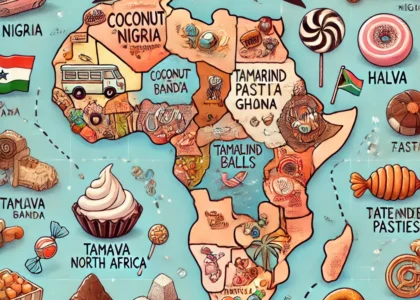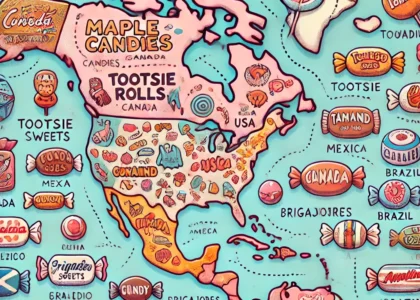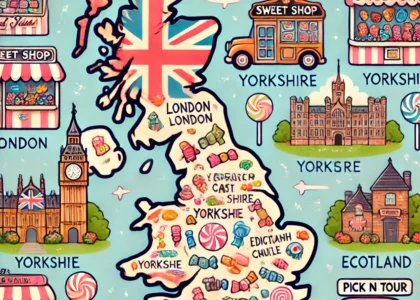Introduction
The confectionery landscape in the United Kingdom has undergone dramatic changes over the past five decades, from the classic retro sweets of the 1970s, 1980s, and 1990s to today’s contemporary candy offerings. While many retro sweets such as Sherbet Fountains, Fruit Salads, Black Jacks, and Flying Saucers remain celebrated for their taste and nostalgic value, modern candy has shifted in terms of flavour profiles, packaging, marketing strategies, and production methods.
This article provides a comprehensive analysis of the evolution of UK confectionery, comparing retro sweets with modern candies. It examines differences in taste, texture, ingredients, cultural context, and consumer appeal, while exploring the reasons why retro sweets continue to hold a unique place in the collective memory.
1. Historical Context of Retro Sweets
1.1 The Rise of Retro Sweets
The 1970s marked a period of innovation in UK confectionery. Companies like Barratt, Swizzels Matlow, Taveners, and Cadbury expanded their product lines to include a wide variety of chews, fizzy sweets, and chocolate bars. Innovations included:
- Interactive Sweets: Dip Dabs and Sherbet Fountains combined taste and play, creating engaging experiences for children.
- Novel Textures: Chalky wafers, chewy fruit-flavoured sweets, and fizzy tablets added complexity to traditional confectionery.
- Vivid Packaging: Bright, bold packaging designed to attract children’s attention and enhance brand recognition.
By the 1980s and 1990s, retro sweets had become both affordable treats and cultural artefacts, forming a shared lexicon of taste among UK children.
1.2 Cultural Influence
Retro sweets were not just food; they were social experiences. Corner shops, tuck shops, and pick n mix counters encouraged communal participation and interaction. Sweets served as conversation starters, rewards, and social currency among children. The nostalgia associated with these candies continues to influence consumer behaviour today.
2. Key Differences Between Retro Sweets and Modern Candy
2.1 Flavour Profiles
- Retro Sweets: Often tangy, sour, or strongly flavoured. Examples include Black Jacks (licorice), Sherbet Lemons (chalky citrus), and Fruit Salads (tangy chewy fruits).
- Modern Candy: Tends to favour uniform sweetness, with less emphasis on experimental or strong flavours. Fruit flavours are often artificial or muted.
Analysis: The bold and varied flavours of retro sweets created a more memorable taste experience, contributing to their enduring popularity.
2.2 Texture and Consumption Experience
- Retro Sweets: Textures ranged from chalky, fizzy, chewy, to hard. Many sweets required interaction, such as dipping or dissolving.
- Modern Candy: Softer, easier-to-eat textures dominate, with less emphasis on interactive experiences. Chewy sweets are generally uniform in texture, and many chocolate products prioritize smooth consistency over novelty.
Implication: Retro sweets engaged multiple senses simultaneously, enhancing emotional and nostalgic attachment.
2.3 Packaging and Branding
- Retro Sweets: Packaging was vibrant, often featuring bold typography, playful characters, and decade-specific imagery. Packaging often reflected social trends and youth culture.
- Modern Candy: Emphasizes minimalism, brand uniformity, and adult appeal, especially in globalized markets. Retro branding survives mainly through “retro edition” releases, nostalgia marketing, or artisanal brands.
Conclusion: Packaging contributed significantly to retro sweets’ cultural impact and memory recall.
2.4 Ingredients and Production
- Retro Sweets: Higher sugar content, use of natural flavours, and chalky components were common. Preservatives and artificial stabilizers were minimal compared to today.
- Modern Candy: Often includes emulsifiers, stabilizers, and additives to extend shelf life, improve consistency, and comply with modern food regulations.
Impact: Changes in ingredients reflect both regulatory evolution and modern consumer preferences for safety, consistency, and health-conscious alternatives.
3. Marketing and Consumer Engagement
3.1 Television and Print Media
Retro sweets were marketed heavily through television advertisements, comic inserts, and colourful print campaigns. Children’s exposure to media directly influenced brand recognition and purchase behaviour.
3.2 Modern Marketing Approaches
Contemporary candies rely more on:
- Social Media: Instagram, TikTok, and YouTube campaigns targeting both children and adults.
- Influencer Marketing: Nostalgia-driven collaborations or brand partnerships.
- Online Retailing: Focused on convenience, subscription boxes, and e-commerce availability.
Observation: Retro sweets relied on direct emotional engagement, while modern candy leverages digital marketing and consumer data analytics.
4. The Nostalgia Factor
Nostalgia is a key driver of retro sweets’ continued popularity:
- Adults purchase retro sweets as gifts or indulgences, recalling childhood memories.
- Retro sweets create intergenerational connections, allowing parents to share experiences with children.
- Limited editions and revival releases (e.g., 1980s-themed candy packs) capitalize on emotional attachment.
Psychological Perspective: Flavours, packaging, and textures function as memory cues, stimulating the hippocampus and evoking positive emotional responses.
5. Case Studies: Comparing Retro and Modern Candy
5.1 Dip Dabs vs Modern Fizz Candy
- Dip Dabs (retro): Strawberry stick with tangy sherbet powder; interactive and playful.
- Modern fizz candy: Individually packaged tablets with uniform sourness; less engagement.
Insight: The retro format encourages interaction, social sharing, and memorable experiences.
5.2 Fruit Salads vs Contemporary Chews
- Fruit Salads: Chewy, tangy fruit-flavoured discs; multisensory consumption.
- Modern chews: Uniform sweetness, often wrapped individually; limited novelty.
5.3 Black Jacks and Licorice Sweets
- Licorice-based retro sweets were strong-flavoured and polarizing. Modern candy rarely produces such bold flavours due to mass-market appeal considerations.
6. Regional and Rare Sweets
Retro sweets often included region-specific or limited edition varieties that modern candy rarely replicates. Examples include:
- Seasonal festival treats from the 1970s and 1980s
- Local pick n mix exclusives only available in certain towns
- Promotional experimental flavours now highly collectible
Conclusion: The scarcity and uniqueness of retro sweets contribute to their perceived value and nostalgic appeal.
7. Modern Innovations Influenced by Retro Sweets
Despite differences, retro sweets have inspired modern innovations:
- Retro Revival Lines: Brands reintroduce classic flavours in updated packaging.
- Hybrid Products: Chocolate-coated chews or fizzy candies inspired by vintage textures.
- Themed Gift Boxes: Packaging retro sweets as gifts for adults capitalizes on nostalgia.
8. Health and Dietary Considerations
Modern candy production reflects increased awareness of dietary concerns:
- Reduced sugar options
- Allergen labeling
- Vegan or plant-based alternatives
- Emphasis on portion control
Retro sweets often had higher sugar content and limited labeling, reflecting different consumer norms and regulatory frameworks.
9. Socioeconomic and Cultural Implications
- Retro sweets illustrate childhood culture in post-war and late 20th century UK.
- Modern candy reflects globalization, industrial scaling, and regulatory compliance.
- The enduring appeal of retro sweets highlights consumer desire for authenticity, memory, and multisensory experiences in a digital age.
10. Conclusion
The evolution from retro sweets to modern candy demonstrates profound shifts in taste, texture, packaging, marketing, and production. Retro sweets remain culturally and emotionally significant due to:
- Bold flavours and interactive consumption
- Iconic packaging and marketing
- Nostalgia-driven appeal across generations
Modern candy, while safer and more consistent, often lacks the sensory and emotional complexity of its retro predecessors. As a result, retro sweets continue to thrive in pick n mix counters, specialty shops, and themed gift boxes, bridging the gap between culinary history and contemporary indulgence.
By understanding these differences, confectionery enthusiasts, event planners, and collectors can appreciate not only the taste of sweets but also their role as cultural artifacts, memory triggers, and markers of UK confectionery heritage.





